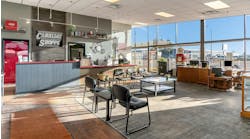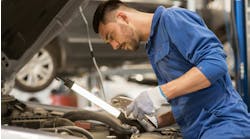Scheduling is an aspect of the collision repair process that’s streamlined daily. Doing so is the only way to properly plan for the additional damage that’s discovered after disassembly, Bob Langlie says. Langlie is the general manager of Luther Collision and Glass in Fargo, N.D., where he runs a 16,000-square-foot, 18-employee shop that turns out an average of 250 vehicles per month and $4.5 million per year with technician efficiency sitting at 210 percent, productivity at 110 percent, cycle time at three days and touch time at 4.5 hours.
Langlie explains his scheduling method that allows for the shop to produce those numbers and keep running at maximum capacity.
1. Manage the numbers.
We use the Profit Net System from Axalta to help us tweak the numbers. They have an arrival calendar in there and we’re able to put in the amount of hours we want scheduled for a particular day. For us, we’ve found that’s roughly 12 hours per day. Every shop is going to be different based on productivity, which is why it’s crucial to understand what your staff is capable of. You have to custom tune how many hours you’re able to take in each day and still allow for that supplemental damage you’re going to get and move on from there.
2. Measure technician efficiency.
Again, this is all based on the techs you happen to have. If you happen to have a tech that can do 80 hours per week, obviously you can schedule more hours than if you have one that can do 40 hours per week. I’m extremely blessed to have a group of technicians that have been here a long time. But bottom line: I know what they’re capable of. I know better than them what they’re able to produce, as far as work.
3. Schedule based on technician specialties.
We try to schedule based on talent. If I have one person in the shop who’s really good on quarter panels, I try to schedule so he gets quarter panel jobs because he’s going to be the most productive on it. I come from a service background and that’s something I’ve carried over to the collision side. From the service side, the first thing we did is analyze our tech’s strengths. My job is to make sure each tech got, whenever possible, the work that he is the best at. He’ll make more money and we’ll make more money. All our guys are commission so they want to do what they're better at.
4. Stagger the paint team.
My collision side works independently, while the paint technicians are on a team. That way we can better utilize the paint booth. We just worry about scheduling the body side and we have the paint side set up to handle anything the body side can do. I have three full time painters. We’ve found that the best way to go is this and extend the hours a little bit by starting earlier in the morning and working a little later. Even a couple hours or working over the noon hour gives us three more cars per day than working the usual 8-5.
5. Leave wiggle room.
We actually schedule 80 percent of our effective productivity. I figure out what each tech is capable of in a week and we leave about 20–25 percent open to handle supplemental damage. We’re blessed with an abundance of work. If we don’t have supplements, I’ve always got extra work that I can bring in. At 20–25 percent, that’s about our best to fit in the stuff that needs to get in with the supplements. That keeps us pretty close to maximum efficiency.
6. Only use systems that work effectively in the shop.
We use a modified lean and blueprinting system in the shop. We don’t do the markers and go over everything but the file handler does go over the car after the tech takes it apart to make sure we’ve got everything upfront. It’s a modified blueprint to make sure he gets everything upfront. I understand the blueprint system and I’ve gone through many lean system programs. My thinking is that my guys are doing fine, our efficiencies are high and we’re not waiting on parts. If it’s not broken, don’t fix it.
7. Disassemble bigger hits.
We try to disassemble the bigger hits as much as possible before we finish an estimate. With these big hits, you only have so much room to store parts so the more you can take apart when you’re doing the estimate, the better. The more you take apart and finish the estimate up front, the more efficient you’re going to be on the backside.



